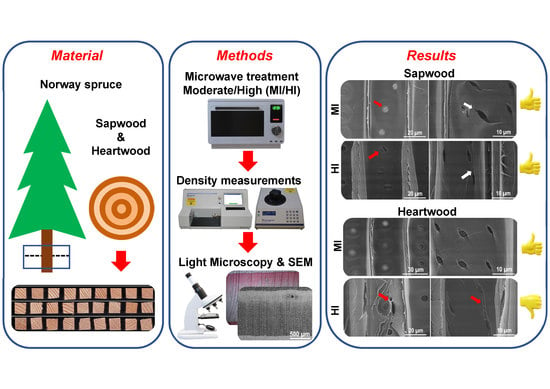Effects of Different Energy Intensities of Microwave Treatment on Heartwood and Sapwood Microstructures in Norway Spruce
Abstract
1. Introduction
2. Materials and Methods
2.1. Materials
2.2. Microwave Treatment
2.3. Pycnometric Density Measurements
2.4. Light Microscopy and Scanning Electron Microscopy
2.5. Data Analysis
3. Results and Discussion
3.1. Pycnometric Density
3.2. Light Microscopy and Scanning Electron Microscopy of Microwave-Treated Samples
3.3. Moderate Intensity Microwave Treated Heartwood and Sapwood
3.4. High-Intensity Microwave Treated Heartwood and Sapwood
4. Conclusions
Author Contributions
Funding
Institutional Review Board Statement
Informed Consent Statement
Data Availability Statement
Acknowledgments
Conflicts of Interest
References
- Boonstra, M. A Two-Stage Thermal Modification of Wood. Ph.D. Thesis, Laboratory of Wood Technology, Ghent University, Ghent, Belgium, 2008. [Google Scholar]
- Hom, S.K.; Ganguly, S.; Samani, A.; Tripathi, S. Improvement in Fire Retardancy with Double-Step Chemical Modification on Pinus Radiata D. Don Using Dimethyl Methylphosphonate with Propylene Oxide and Maleic Anhydride. Int. Wood Prod. J. 2020, 11, 138–145. [Google Scholar] [CrossRef]
- Humar, M.; Lesar, B.; Kržišnik, D. Moisture Performance of Façade Elements Made of Thermally Modified Norway Spruce Wood. Forests 2020, 11, 348. [Google Scholar] [CrossRef]
- Sandberg, D.; Kutnar, A.; Mantanis, G. Wood Modification Technologies—A Review. Iforest Biogeosciences For. 2017, 10, 895–908. [Google Scholar] [CrossRef]
- Matsuda, H. Preparation and Utilization of Esterified Woods Bearing Carboxyl Groups. Wood Sci. Technol. 1987, 21, 75–88. [Google Scholar] [CrossRef]
- Matsuda, H. Preparation and Properties of Oligoesterified Wood Blocks Based on Anhydride and Epoxide. Wood Sci. Technol. 1992, 27, 23–34. [Google Scholar] [CrossRef]
- Kim, G.; Yun, K.-E.; Kim, J.-J. Effect of Heat Treatment on the Decay Resistance and the Bending Properties of Radiata Pine Sapwood. Mater. Organ. 1998, 32, 101–108. [Google Scholar]
- Donath, S.; Militz, H.; Mai, C. Wood Modification with Alkoxysilanes. Wood Sci. Technol. 2004, 38, 555–566. [Google Scholar] [CrossRef]
- Hansmann, C.; Weichslberger, G.; Gindl, W. A Two-Step Modification Treatment of Solid Wood by Bulk Modification and Surface Treatment. Wood Sci. Technol. 2005, 39, 502–511. [Google Scholar] [CrossRef]
- Radovan, D.; Hasan, M.; Jug, M.; Bogoslav, Š. Biological Durability of Wood Modified by Citric Acid. Drv. Ind. 2008, 59, 55–59. [Google Scholar]
- Esteves, B.; Pereira, H. Wood Modification by Heat Treatment: A Review. BioResources 2009, 4, 370–404. [Google Scholar] [CrossRef]
- Bogoslav, Š.; Trajković, J.; Hasan, M.; Drago, K.; Bischof, S.; Martina, F. Dimensional Stability of Wood Modified by Citric Acid Using Different Catalysts. Drv. Ind. 2009, 60, 23–26. [Google Scholar]
- Treu, A.; Nunes, L.; Larnøy, E. Macrobiological Degradation of Esterified Wood with Sorbitol and Citric Acid. Forests 2020, 11, 776. [Google Scholar] [CrossRef]
- Hom, S.; Ganguly, S.; Bhoru, Y.; Samani, A. Effect of Chemical Modification on Dimensional Stability of Pinus Radiata D. Don Using Acetic Anhydride. J. For. Sci. 2020, 66, 208–217. [Google Scholar] [CrossRef]
- Sethy, A.K.; Torgovnikov, G.; Vinden, P.; Przewloka, S. Moisture Conditioning of Wood Using a Continuous Microwave Dryer. Dry. Technol. 2016, 34, 318–323. [Google Scholar] [CrossRef]
- Torgovnikov, G.; Vinden, P. High-Intensity Microwave Wood Modification for Increasing Permeability. For. Prod. J. 2009, 59, 84–92. [Google Scholar]
- Sethy, A.K.; Vinden, P.; Torgovnikov, G.; Militz, H.; Mai, C.; Kloeser, L.; Przewloka, S. Catalytic Acetylation of Pinus Radiata (D. Don) with Limited Supply of Acetic Anhydride Using Conventional and Microwave Heating. J. Wood Chem. Technol. 2012, 32, 1–11. [Google Scholar] [CrossRef]
- Dashti, H.; Termian, A.; Faezipour, M.; Shahverdi, M. Effect of Microwave Radiation and Pre-Steaming Treatments on the Conventional Drying Characteristics of Fir Wood (Abies Alba L.). Lignocellulose 2015, 1, 166–173. [Google Scholar]
- Terziev, D.; Daniel, G. Application of high frequency treatments for improved permeability of Norway spruce (Picea abies Karst.) wood. Wood Best Mater. Mank. 2013, 15–19. Available online: https://www.researchgate.net/publication/263888431 (accessed on 1 April 2021).
- Ramezanpour, M.; Tarmian, A.; Taghiyari, H.R. Improving Impregnation Properties of Fir Wood to Acid Copper Chromate (ACC) with Microwave Pre-Treatment. Iforest Biogeosciences For. 2014, 8, e1–e6. [Google Scholar] [CrossRef]
- Vinden, P.; Torgovnikov, G.; Sethy, A.K. Conveyor Belt Pressure Impregnation of Wood. In Wood is Good; Springer: Singapore, 2017; pp. 227–242. [Google Scholar]
- Samani, A.; Ganguly, S.; Kanyal, R.; Tripathi, S. Effect of Microwave Pre-Treatment on Preservative Retention and Treatability of Melia Composita Wood. J. For. Sci. 2019, 65, 391–396. [Google Scholar] [CrossRef]
- Vinden, P.; Torgovnikov, G. The Physical Manipulation of Wood Properties Using Microwave. In Proceedings of the Future of Eucalypts for Wood Products, International Conference of IUFRO, The Future of Eucalyptus for Wood Production, Tasmania, Australia, 19–24 March 2000; pp. 240–247. [Google Scholar]
- Torgovnikov, G.; Vinden, P. Microwave Wood Modification Technology and Its Applications. For. Prod. J. 2010, 60, 173–182. [Google Scholar] [CrossRef]
- Hong-Hai, L.; Wang, Q.; Lin, Y.; Tao, J.; Ying-Chun, C. Modification of Larch Wood by Intensive Microwave Irradiation. J. For. Res. 2005, 16, 237–240. [Google Scholar] [CrossRef]
- Dömény, J.; Koiš, V.; Dejmal, A. Microwave Radiation Effect on Axial Fluid Permeability in False Heartwood of Beech (Fagus Sylvatica L.). BioResources 2013, 9. [Google Scholar] [CrossRef][Green Version]
- He, S.; Lin, L.; Fu, F.; Zhou, Y.; Fan, M. Microwave Treatment for Enhancing the Liquid Permeability of Chinese Fir. Bioresources 2014, 9, 1924–1938. [Google Scholar]
- Vongpradubchai, S.; Rattanadecho, P. The Microwave Processing of Wood Using a Continuous Microwave Belt Drier. Chem. Eng. Process. Process Intensif. 2009, 48, 997–1003. [Google Scholar] [CrossRef]
- Wang, D.; Peng, L.; Zhu, G.; Fu, F.; Zhou, Y.; Song, B. Improving the Sound Absorption Capacity of Wood by Microwave Treatment. BioResources 2014, 9. [Google Scholar] [CrossRef]
- Terziev, N.; Daniel, G.; Torgovnikov, G.; Vinden, P. Effect of Microwave Treatment on the Wood Structure of Norway Spruce and Radiata Pine. Bioresources 2020, 15, 5616. [Google Scholar] [CrossRef]
- Weng, X.; Zhou, Y.; Fu, Z.; Gao, X.; Zhou, F.; Fu, F. Effects of Microwave Treatment on Microstructure of Chinese Fir. Forests 2020, 11, 772. [Google Scholar] [CrossRef]
- Merela, M.; Thaler, N.; Balzano, A.; Plavčak, D. Optimal Surface Preparation for Wood Anatomy Research of Invasive Species by Scanning Electron Microscopy = Optimalna Priprema Površine Drva Za Istraživanje Anatomije Invazivnih Vrsta Drva Pretražnim Elektronskim Mikroskopom. Drv. Ind. 2020, 71, 117–127. [Google Scholar]
- Merela, M.; Turičnik, V.; Vek, V.; Oven, P. Anatomical, chemical and sorption properties of sapwood and heartwood of scots pine. Acta Silvae Et Ligni 2019, 119, 43–54. [Google Scholar]
- Merela, M.; Čufar, K. Density and Mechanical Properties of Oak Sapwood versus Heartwood in Three Different Oak Species. Drv. Ind. 2013, 64, 323–334. [Google Scholar] [CrossRef]
- Kol, H.; Çayir, B. Increasing the Impregnability of Oriental Spruce Wood via Microwave Pretreatment. Bioresources 2021, 16, 2513–2523. [Google Scholar] [CrossRef]
- MIC (Micromeritics Instrument Corporation). GeoPyc 1365 Operator Manual; Micromeritics Instrument Corporation: Norcross, GA, USA, 2017. [Google Scholar]
- Čufar, K.; Merela, M.; Erič, M. A Roman Barge in the Ljubljanica River (Slovenia): Wood Identification, Dendrochronological Dating and Wood Preservation Research. J. Archaeol. Sci. 2014, 44, 128–135. [Google Scholar] [CrossRef]
- Merela, M.; Habjan, P.; Čufar, K. Formation of Xylem and Phloem in Europena Beech Tree after Ice Storm Damage. Acta Silvae Ligni 2016, 110, 3–13. [Google Scholar] [CrossRef][Green Version]
- Oven, P.; Merela, M.; Mikac, U.; Serša, I. Application of 3D Magnetic Resonance Microscopy to the Anatomy of Woody Tissues. IAWA J. 2011, 32, 401–414. [Google Scholar] [CrossRef]
- Balzano, A. Xylem Plasticity in Pinus Pinaster and Quercus Ilex Growing at Sites with Different Water Availability in the Mediterranean Region: Relations between Intra-Annual Density Fluctuations and Environmental Conditions. Forests 2020, 11, 379. [Google Scholar] [CrossRef]
- Rasband, W. ImageJ: Image Processing and Analysis in Java. Astrophys. Source Code Libr. 2012, 1, 06013. [Google Scholar]
- Scott, C.T.; Klungness, J.; Lentz, M.; Horn, E.; Akhtar, M. Microwaving Logs for Energy Savings and Improved Paper Properties for Mechanical Pulps. In Proceedings of the 2002 TAPPI Fall Technical Conference and Trade Fair, San Diego, CA, USA, 8–11 September 2002; p. 10. [Google Scholar]
- Arshanitsa, A.; Dizhbite, T.; Bikovens, O.; Pavlovich, G.; Andersone, A.; Telysheva, G. Effects of Microwave Treatment on the Chemical Structure of Lignocarbohydrate Matrix of Softwood and Hardwood. Energy Fuels 2016, 30, 457–464. [Google Scholar] [CrossRef]
- Zhang, Y.; Cai, L. Mechanism for De-Aspirating Pits in Subalpine Fir by Steam Explosion Prior to Drying. Dry. Technol. 2009, 27, 84–88. [Google Scholar] [CrossRef]
- Zhang, Y.; Jia, K.; Cai, L.; Shi, S. Acceleration of Moisture Migration in Larch Wood Through Microwave Pre-Treatments. Dry. Technol. 2013, 31. [Google Scholar] [CrossRef]
- Muzamal, M. Structural Modifications in Spruce Wood during Steam Explosion Pretreatment. Ph.D. Thesis, Chalmers University Of Technology, Gothenburg, Sweden, 2016. [Google Scholar]
- Muzamal, M.; Jedvert, K.; Theliander, H.; Rasmuson, A. Structural Changes in Spruce Wood during Different Steps of Steam Explosion Pretreatment. Holzforschung 2015, 69, 61–66. [Google Scholar] [CrossRef]
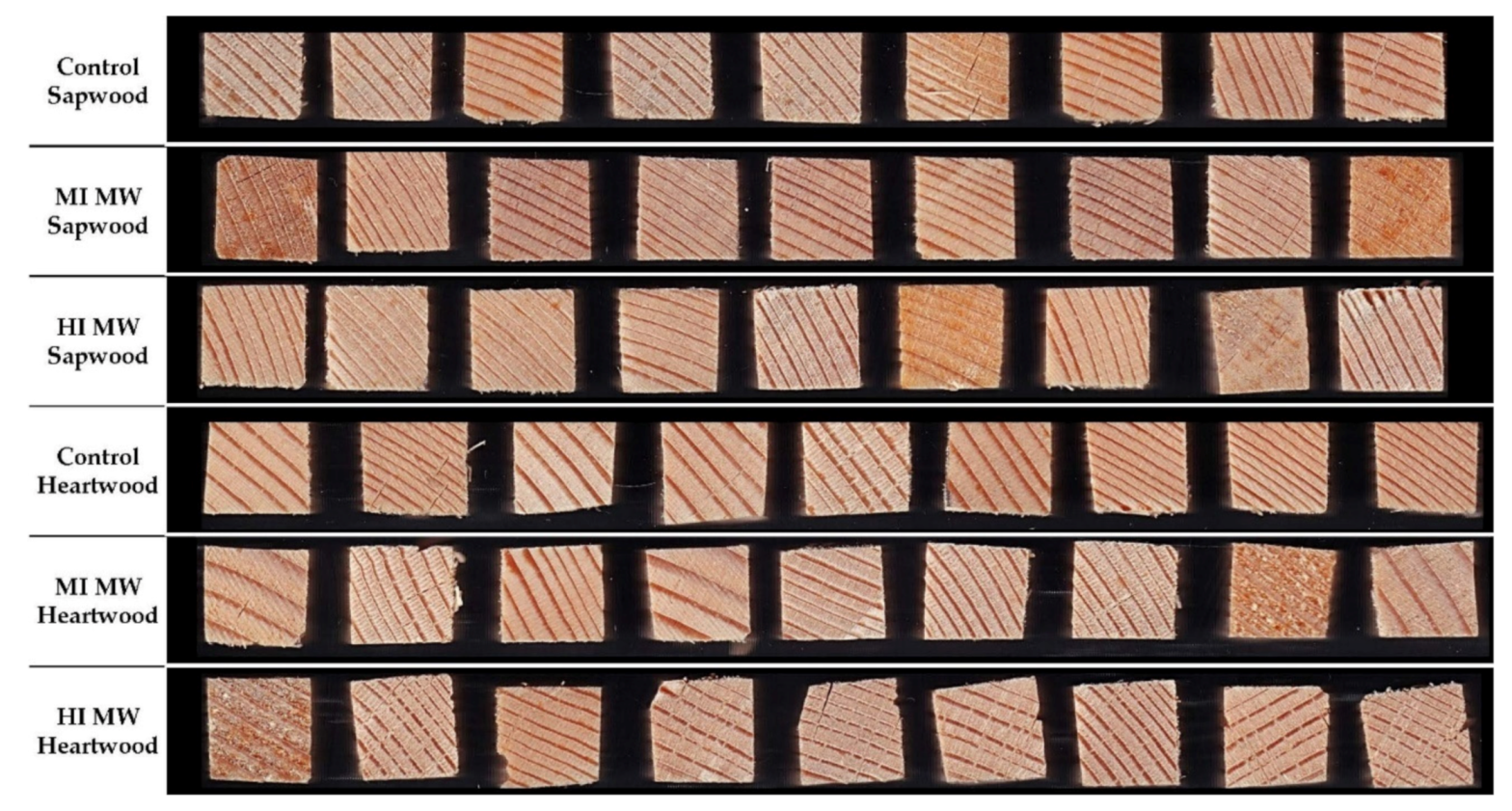
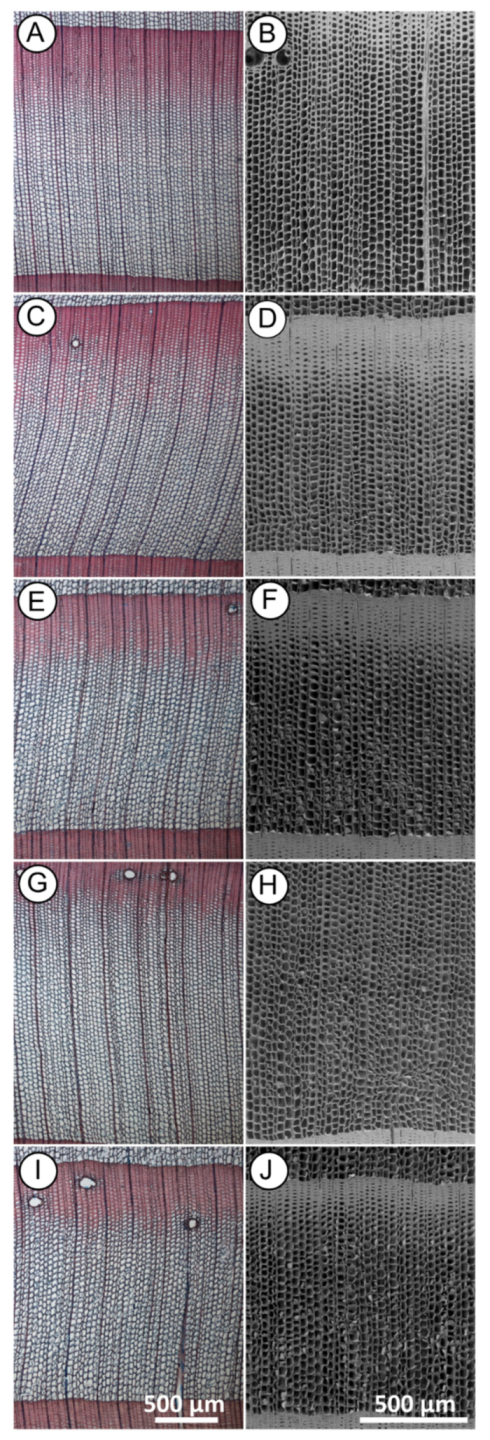
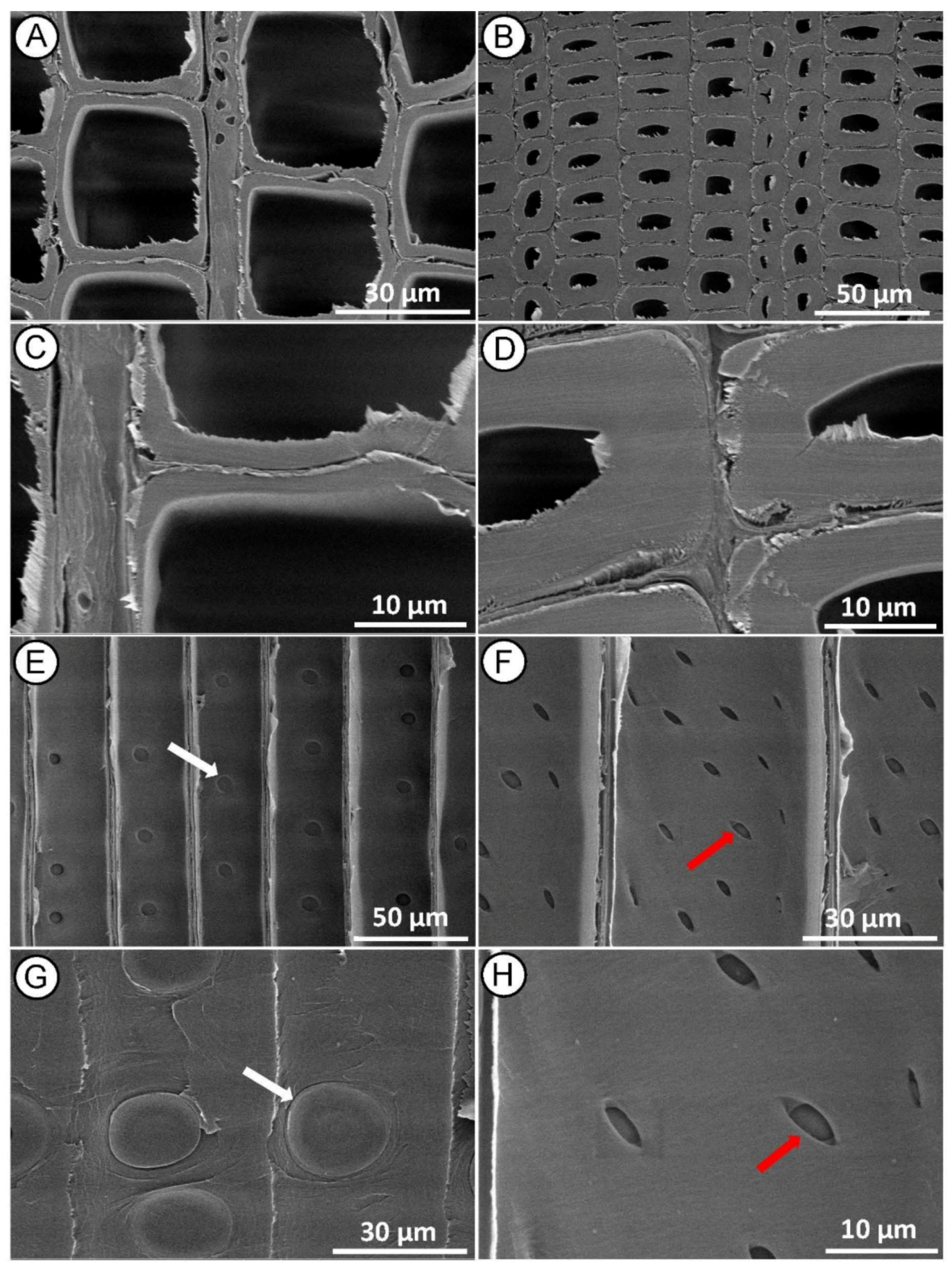
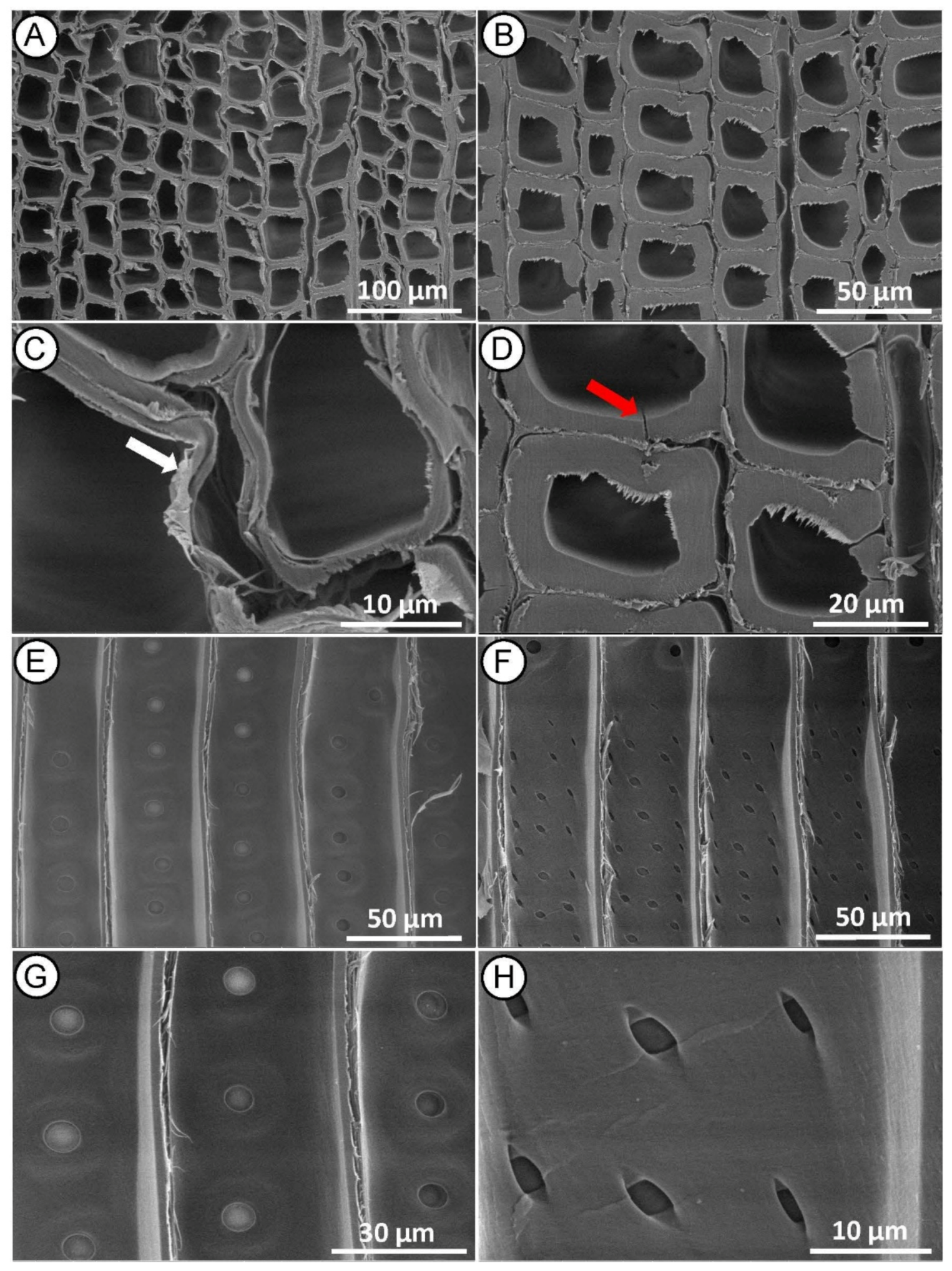

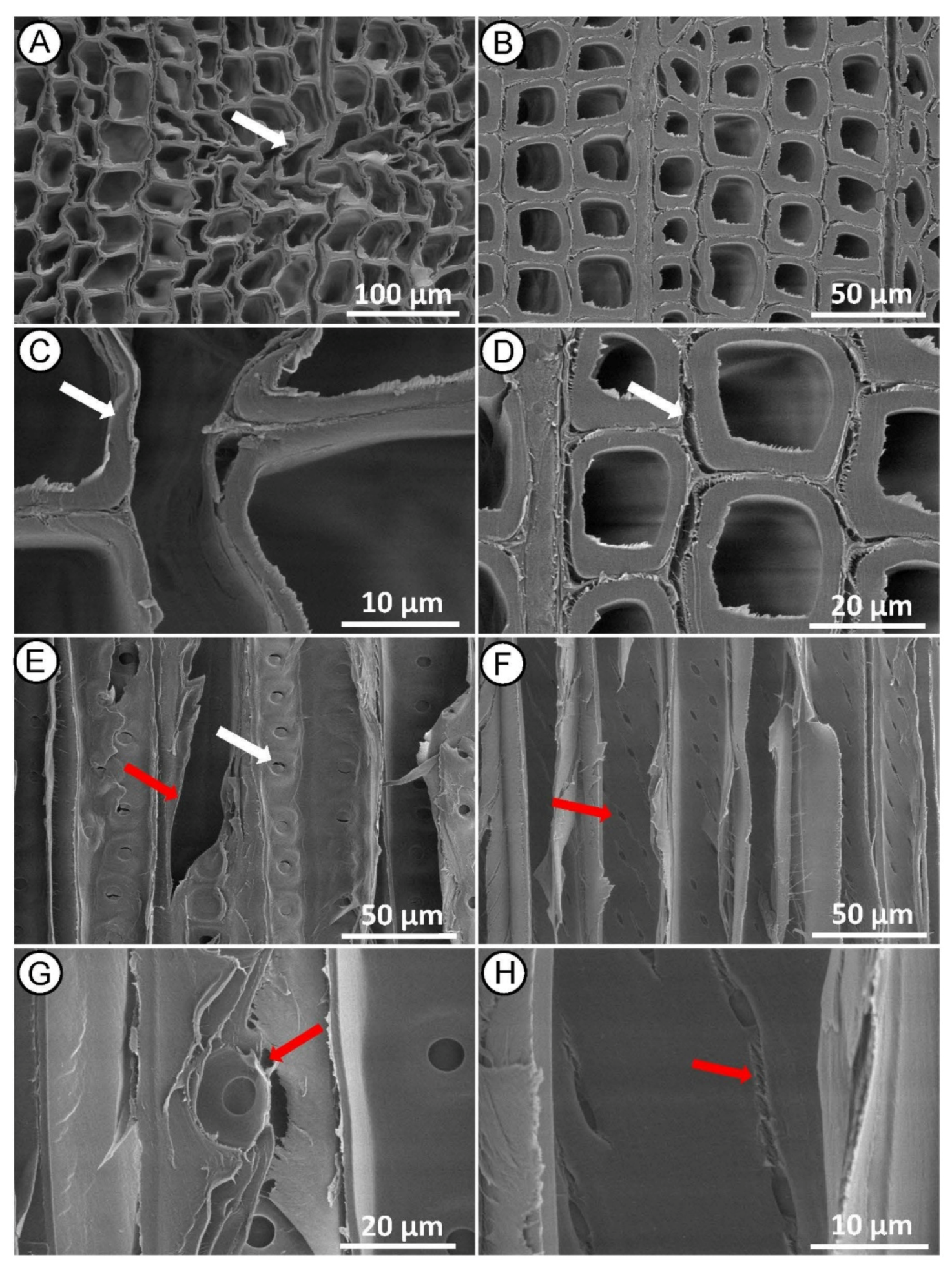
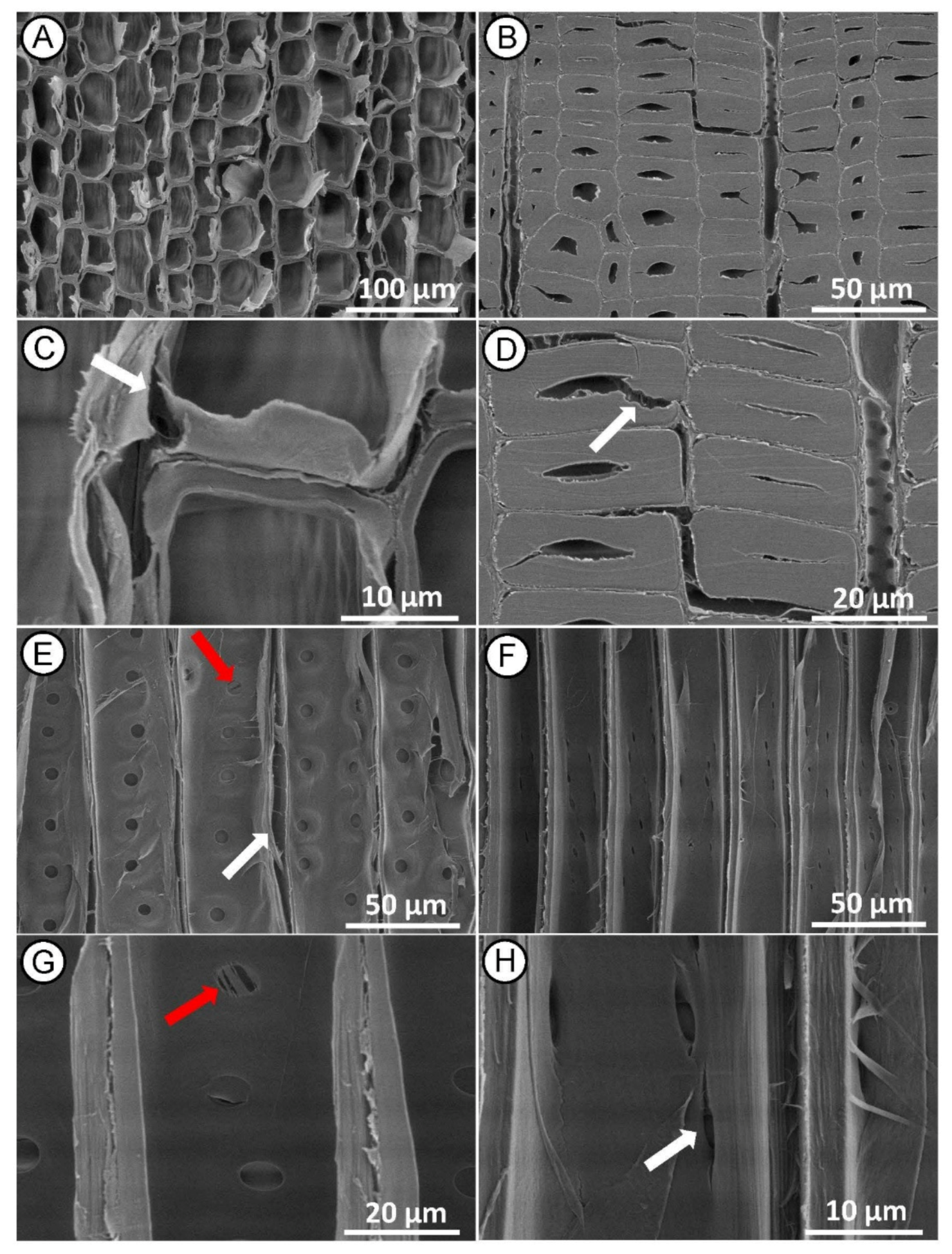
| AccuPyc | GeoPyc | |||||
|---|---|---|---|---|---|---|
| Sample | Skeletal Density (g/cm3) | St. Dev. | Envelope Density (g/cm3) | St. Dev | Specific Pore Volume (cm3/g) | Porosity (%) |
| Control Sapwood | 1.4241 | 0.0025 | 0.5565 | 0.0008 | 1.0955 | 60.92 |
| MI MW Sapwood | 1.4178 | 0.0031 | 0.5324 | 0.0012 | 1.1510 | 61.88 |
| HI MW Sapwood | 1.3611 | 0.0006 | 0.4802 | 0.0012 | 1.3505 | 64.72 |
| Control Heartwood | 1.3577 | 0.0062 | 0.5176 | 0.0019 | 1.1950 | 61.28 |
| MI MW Heartwood | 1.3314 | 0.0039 | 0.4782 | 0.0010 | 1.3400 | 64.08 |
| HI MW Heartwood | 1.2180 | 0.0067 | 0.5085 | 0.0004 | 1.1450 | 59.25 |
Publisher’s Note: MDPI stays neutral with regard to jurisdictional claims in published maps and institutional affiliations. |
© 2021 by the authors. Licensee MDPI, Basel, Switzerland. This article is an open access article distributed under the terms and conditions of the Creative Commons Attribution (CC BY) license (https://creativecommons.org/licenses/by/4.0/).
Share and Cite
Ganguly, S.; Balzano, A.; Petrič, M.; Kržišnik, D.; Tripathi, S.; Žigon, J.; Merela, M. Effects of Different Energy Intensities of Microwave Treatment on Heartwood and Sapwood Microstructures in Norway Spruce. Forests 2021, 12, 598. https://doi.org/10.3390/f12050598
Ganguly S, Balzano A, Petrič M, Kržišnik D, Tripathi S, Žigon J, Merela M. Effects of Different Energy Intensities of Microwave Treatment on Heartwood and Sapwood Microstructures in Norway Spruce. Forests. 2021; 12(5):598. https://doi.org/10.3390/f12050598
Chicago/Turabian StyleGanguly, Sauradipta, Angela Balzano, Marko Petrič, Davor Kržišnik, Sadhna Tripathi, Jure Žigon, and Maks Merela. 2021. "Effects of Different Energy Intensities of Microwave Treatment on Heartwood and Sapwood Microstructures in Norway Spruce" Forests 12, no. 5: 598. https://doi.org/10.3390/f12050598
APA StyleGanguly, S., Balzano, A., Petrič, M., Kržišnik, D., Tripathi, S., Žigon, J., & Merela, M. (2021). Effects of Different Energy Intensities of Microwave Treatment on Heartwood and Sapwood Microstructures in Norway Spruce. Forests, 12(5), 598. https://doi.org/10.3390/f12050598










